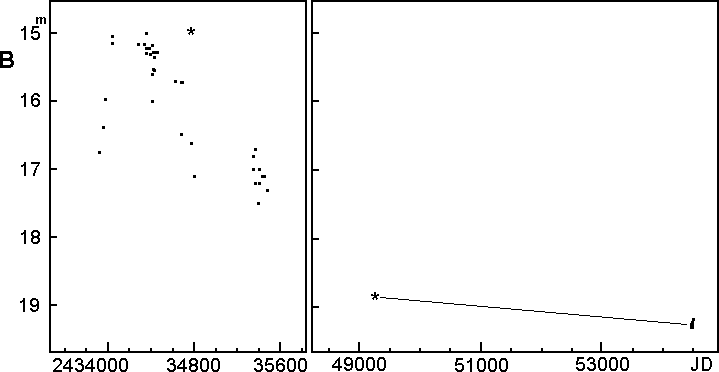|
Peremennye Zvezdy (Variable Stars) 28, No. 11, 2008 Received 19 September; accepted 19 December.
|
Article in PDF |
LW Cassiopeiae and Its Environment
V.P. Goranskij1 and E.A. Barsukova2
- Sternberg Astronomical Institute, 13, University Ave., Moscow 119992,
Russia; e-mail: goray@sai.msu.ru
- Special Astrophysical Observatory, Russian Academy of Sciences, Nizhnij Arkhyz, Karachai-Cherkesia, 369167, Russia
|
Recent multicolor photometry of N. Kurochkin's nova or
novalike variable star LW Cas has been obtained using the SAO 1-m
Zeiss reflector. The amplitude of the outburst in 1952 was 5 |
1. INTRODUCTION
LW Cas (SVS 1144) was discovered by Kurochkin (1953) and
classified as a novalike star or slow nova. It was first detected
on 1951 September 27 (JD 2433917) at the level of 16![]() 55 pg and
reached its maximum at 15
55 pg and
reached its maximum at 15![]() 4 pg on 1952 January 25 (JD 2434037)
after continuous brightening. After the maximum, a very slow decay
with the rate of 0
4 pg on 1952 January 25 (JD 2434037)
after continuous brightening. After the maximum, a very slow decay
with the rate of 0![]() 04 in 100 days and with rare dips was
observed. In a more detailed paper, Kurochkin (1959) published a
ten-year light curve, which showed that the variable star was seen
for 5 years above the limit of photographic plates estimated as
17
04 in 100 days and with rare dips was
observed. In a more detailed paper, Kurochkin (1959) published a
ten-year light curve, which showed that the variable star was seen
for 5 years above the limit of photographic plates estimated as
17![]() . Examining the Palomar Observatory Sky Survey (POSS)
images, he noted that the star was located in the region rich for
bright and dark details of the nebula IC 1848-S6, in the middle of
a small sine-shaped filament of dark matter. The filament is seen
wedged in the main volume of the nebula. Kurochkin described also
a light halo around the star in the POSS negative that might be a
concentration of dark matter to the star's image. He noted that
the image of the star was elongated from east to west and had an
oval shape, in variance to other surrounding stars. This POSS
image was taken in January, 1954 during the outburst. He supposed
that the elongation might be due to binarity of the star or to a
luminous nebular shell.
. Examining the Palomar Observatory Sky Survey (POSS)
images, he noted that the star was located in the region rich for
bright and dark details of the nebula IC 1848-S6, in the middle of
a small sine-shaped filament of dark matter. The filament is seen
wedged in the main volume of the nebula. Kurochkin described also
a light halo around the star in the POSS negative that might be a
concentration of dark matter to the star's image. He noted that
the image of the star was elongated from east to west and had an
oval shape, in variance to other surrounding stars. This POSS
image was taken in January, 1954 during the outburst. He supposed
that the elongation might be due to binarity of the star or to a
luminous nebular shell.
Cohen (1980) described LW Cas (No. 11 in the list) as a highly
absorbed (
![]() ) A0III star having
) A0III star having
![]() . Based on unpublished infrared observations by Herbig,
Cohen noted that the star was associated with a parabolic
nebulosity at whose tip there was an infrared source.
High-frequency radio continuum emission was also observed from the
star. LW Cas is the infrared star IRAS 02534+6029 or 2MASS
025721.6+6041198 (
. Based on unpublished infrared observations by Herbig,
Cohen noted that the star was associated with a parabolic
nebulosity at whose tip there was an infrared source.
High-frequency radio continuum emission was also observed from the
star. LW Cas is the infrared star IRAS 02534+6029 or 2MASS
025721.6+6041198 (
![]() ). Cohen also gave the
following IR indices for LW Cas:
). Cohen also gave the
following IR indices for LW Cas:
![]() .
.
Wenzel and Fuhrmann (1983) took a poorly exposed spectrogram of LW Cas with the Russian 6-m telescope. In this spectrum, LW Cas showed neither emission nor absorption lines. Its nebular appendix to the east was described as a low-excitation nebula. They discussed this star as "an FU Ori type object after a recurrent outburst".
Moffat (1972) estimated the photometric distance to IC 1848 complex as 2.29 kpc, and Georgelin and Georgelin (1970) estimated its spectroscopic distance as 2.30 kpc.
LW Cas entered the field of our interests as a possible red nova candidate with a remnant bright in the infrared range. It is reasonable to study it having in mind that the best-studied red nova, V838 Mon, is a young object, also associated with gas and dust. In that case, circumstellar matter manifested itself through the light echo of the outburst. The amplitude of the 1951 outburst of LW Cas is still unknown, and we performed special photometry to study the star in the quiescent state and to revise Kurochkin's eye estimates during the outburst.
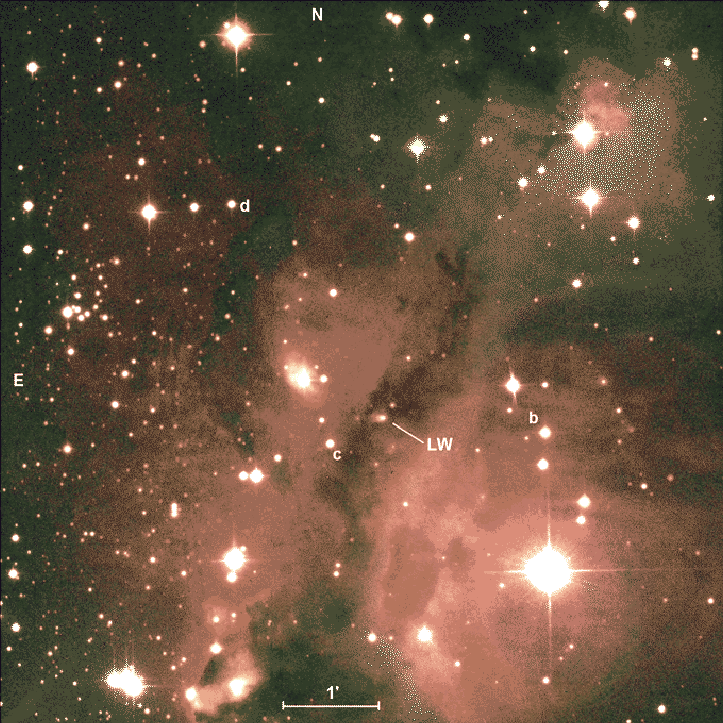 |
Fig. 1. A color picture of LW Cas and its surroundings. Stars b, c, and d are comparison stars used by N.E. Kurochkin for eye estimates. This frame was taken with the SAO 1-m Zeiss telescope. |
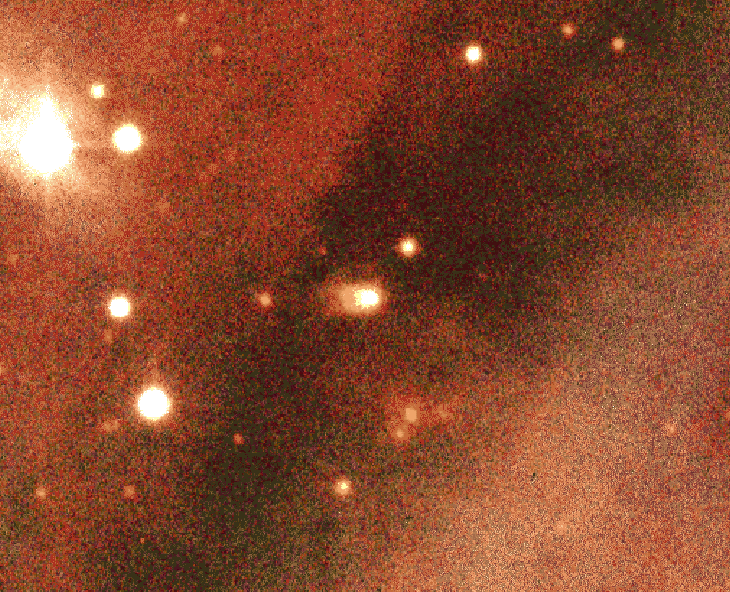 |
Fig. 2. LW Cas (in the center) and its close neighborhood. A fragment of the frame taken with the SAO 1-m Zeiss telescope. |
2. OBSERVATIONS
Our ![]() photometry was performed using the 1-meter Zeiss
reflector of the Special Astrophysical Observatory with an EEV
42-40 CCD on 2008 January 2, 12, 13 and February 3. In these
frames, the image scale is 0
photometry was performed using the 1-meter Zeiss
reflector of the Special Astrophysical Observatory with an EEV
42-40 CCD on 2008 January 2, 12, 13 and February 3. In these
frames, the image scale is 0
![]() 22 per pixel with binning 1 and
0
22 per pixel with binning 1 and
0
![]() 44 per pixel with binning 2. The best seing,
44 per pixel with binning 2. The best seing,
![]() , was on January 13. On that night, we
accumulated deep frames with the exposures of 600 s in the
, was on January 13. On that night, we
accumulated deep frames with the exposures of 600 s in the ![]() and
and
![]() filters and of 900 s in the
filters and of 900 s in the ![]() filter to get high-resolution
color images of LW Cas and its surroundings. The color image of
the IC 1888-S6 region is shown in Fig. 1. This image was cleaned
for traces of cosmic particles, hot pixels, and chip defects. The
original uncleaned 25-Mb color FITS-format frame and its cleaned
bitmap image can be downloaded from Vitaly Goranskij's web site
(http://jet.sao.ru/
filter to get high-resolution
color images of LW Cas and its surroundings. The color image of
the IC 1888-S6 region is shown in Fig. 1. This image was cleaned
for traces of cosmic particles, hot pixels, and chip defects. The
original uncleaned 25-Mb color FITS-format frame and its cleaned
bitmap image can be downloaded from Vitaly Goranskij's web site
(http://jet.sao.ru/![]() goray/lwcas/lw1color.fts and
.../lw1color1.bmp).
goray/lwcas/lw1color.fts and
.../lw1color1.bmp).
Figure 1 demonstrates IC 1888-S6 as a complex structure including
star clusters, gas and dust nebulae. Some bright and faint stars
are embedded in the gas and dust matter. The star light is
absorbed by dust as well as reflected by dust clouds. The
reflected light may be blue as at the NW edge of nebula, yellow as
at the SE edge, or red as in the center depending on the color of
the star. The brightest and hottest star in the right bottom of
the frame ionizes hydrogen in its far vicinity. LW Cas is blocked
by the belt of dark matter going from the SE to the NW edge of
nebulosity and having cloudy structure. In 17
![]() to SW of
LW Cas, three stars surrounded by common bright nebulosity are
also blocked by the same dark belt. Some dark details of this belt
have a strange V-shape.
to SW of
LW Cas, three stars surrounded by common bright nebulosity are
also blocked by the same dark belt. Some dark details of this belt
have a strange V-shape.
 |
Fig. 3. The cometary nebula of LW Cas: (a) January, 2008; (b) January, 1954 (POSS-E). Both images are reduced to the same scale. The POSS red image is elongated due to light echo. |
The enlarged fragment of the dark belt is shown in Fig. 2. In this
Figure, we do not see the dark halo around the star noted by
Kurochkin (1959) as a light one on the POSS negative, nothing can
be treated here as a dark globula. LW Cas itself has a comet-like
tail directed to the east that can be traced for 7
![]() in our
best frames (Fig. 3a). High-contrast images show that the star
with a tail is located in a faint ellipsoidal nebulosity,
in our
best frames (Fig. 3a). High-contrast images show that the star
with a tail is located in a faint ellipsoidal nebulosity,
![]() in size. In Fig. 3a, the tail of LW Cas looks
like an empty conic or paraboloidal structure. With the given
resolution, one can suggest a different interpretation of this
image as a star located at the tip of a dark and dense, elongated
conic structure resembling a pillar or an `elephant trunk' (which
are met in other star-forming regions), and the star illuminates
the nearby sides of this structure.
in size. In Fig. 3a, the tail of LW Cas looks
like an empty conic or paraboloidal structure. With the given
resolution, one can suggest a different interpretation of this
image as a star located at the tip of a dark and dense, elongated
conic structure resembling a pillar or an `elephant trunk' (which
are met in other star-forming regions), and the star illuminates
the nearby sides of this structure.
On two nights with stable air transparency, we made absolute
measurements of two Kurochkin's standard stars in this region, b
and c. These data are given in Table 1. The ![]() data in this
Table are taken from 2MASS.
data in this
Table are taken from 2MASS.
| Star | |||||||
| b | 15 |
14 |
13 |
12 |
11 |
10 |
10 |
| c | 16.78 | 15.84 | 15.30 | 14.73 | 13.59 | 13.17 | 13.04 |
LW Cas itself was measured using an aperture of 5
![]() 2 diameter
centered on the star in the CCD frames. The results of our
2 diameter
centered on the star in the CCD frames. The results of our
![]() photometry are presented in Table 2.
photometry are presented in Table 2.
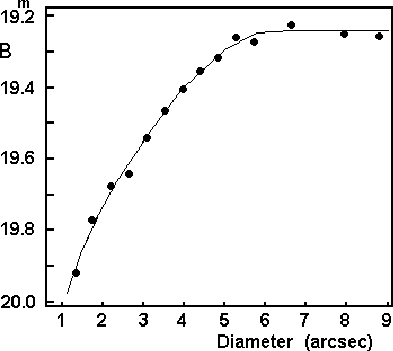 |
Fig. 4. The dependence of the brightness of LW Cas on the aperture diameter. This dependence reveals the nonstellar structure of the central object. |
| JD 2454... | ||||
| 468.300 | 19 |
17 |
16 |
15 |
| 478.219 | 19.27 | 17.73 | 16.57 | 15.26 |
| 479.297 | 19.29 | 17.70 | 16.57 | - |
| 479.312 | 19.25 | 17.72 | 16.57 | - |
| 479.321 | 19.25 | 17.71 | 16.57 | - |
| 500.244 | 19.17 | 17.67 | 16.51 | 15.28 |
Additionally, we remeasured all Kurochkin's standard stars to
correct his photographic magnitude scale used for eye estimates.
The corrected magnitude in maximum transferred to the photometric
![]() scale is 15
scale is 15![]() 0. The mean magnitude in minimum given in
Table 2,
0. The mean magnitude in minimum given in
Table 2,
![]() , was measured using a 5
, was measured using a 5
![]() 2
aperture, it is apparently distorted by the surrounding nebula. We
tried to estimate the contribution of the star and the nebula to
the photometric magnitudes using measurements with different
apertures, in the range between 1
2
aperture, it is apparently distorted by the surrounding nebula. We
tried to estimate the contribution of the star and the nebula to
the photometric magnitudes using measurements with different
apertures, in the range between 1
![]() 3 and 8
3 and 8
![]() 8. The
8. The
![]() -band CCD frame taken on 2008 January 13 with the resolution of
FWHM = 1
-band CCD frame taken on 2008 January 13 with the resolution of
FWHM = 1
![]() 0 was used. Figure 4 shows the relation between the
measured magnitude of LW Cas and the diameter of the aperture.
This Figure reveals that the central object does not have a
stellar structure but possesses a halo that contributes
approximately a half of its light. The extrapolated magnitude of
the central star in the 1
0 was used. Figure 4 shows the relation between the
measured magnitude of LW Cas and the diameter of the aperture.
This Figure reveals that the central object does not have a
stellar structure but possesses a halo that contributes
approximately a half of its light. The extrapolated magnitude of
the central star in the 1
![]() diaphragm is
diaphragm is
![]() . The halo and tail contribute the same amount of light as
the stellar object. Thus, the amplitude of the central star's
outburst was about 5
. The halo and tail contribute the same amount of light as
the stellar object. Thus, the amplitude of the central star's
outburst was about 5![]() 0 or somewhat larger in the
0 or somewhat larger in the ![]() band. The
star became 100 times brighter in the outburst compared to the
current quiescence.
band. The
star became 100 times brighter in the outburst compared to the
current quiescence.
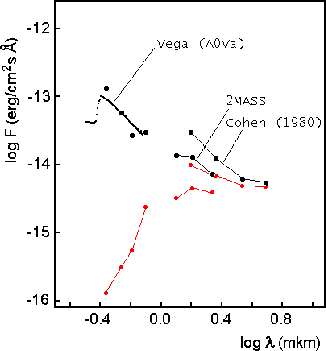 |
Fig. 6. The spectral energy distributions of LW Cas in the optical and infrared bands. Interstellar reddening was taken into account for the black points, no correction was introduced for the red points. The SED of the A0 star Vega is plotted as small points. The SED of Vega is arbitrarily displaced along the flux axis. |
Using remeasured standard stars, we have determined
accurate magnitudes of LW Cas in the two POSS digitized images.
The light curve of LW Cas in Fig. 5 consists of two fragments,
Kurochkin's eye estimates (left) and contemporary data (right).
Asterisks in both panels denote POSS blue plate measurements. The
first POSS observation taken on the night of JD 2434770 is really
brighter by 1![]() than the estimate by Kurochkin on the previous
night, as noted by Kurochkin (1959). POSS blue and red images of
LW Cas are evidently elongated from the east to the west (the POSS
red image is shown in Fig. 3b). This fact is surprising because
the nebulosity around the star contributes the amount of light of
only 20
than the estimate by Kurochkin on the previous
night, as noted by Kurochkin (1959). POSS blue and red images of
LW Cas are evidently elongated from the east to the west (the POSS
red image is shown in Fig. 3b). This fact is surprising because
the nebulosity around the star contributes the amount of light of
only 20![]() and the 16
and the 16![]() central star's image being 40 times
brighter should cover it. We suppose that this was the light echo
that spread along the tail of LW Cas, and it was responsible for
the elongated shape of the image. On the second year of the
outburst, the central star declined by one magnitude relative to
its maximum brightness, and the echo was still bright and
comparable to the star, which determined such a uniformly
elongated shape of the image. The light echo can be expected in
such a dense dusty environment, for such a strong outburst.
central star's image being 40 times
brighter should cover it. We suppose that this was the light echo
that spread along the tail of LW Cas, and it was responsible for
the elongated shape of the image. On the second year of the
outburst, the central star declined by one magnitude relative to
its maximum brightness, and the echo was still bright and
comparable to the star, which determined such a uniformly
elongated shape of the image. The light echo can be expected in
such a dense dusty environment, for such a strong outburst.
The spectral energy distribution (SED) including the optical
photometry and appended with published infrared data is shown in
Fig. 6. The red points are the results of observations not
corrected for interstellar reddening, and the black points are
those corrected for interstellar reddening corresponding to
![]() (Cohen 1980). Small points in Fig. 6 represent the optical
energy distribution of the A0 star Vega published by Glushneva et
al. (1992). The SED of Vega (A0Va) fits well the distribution of
LW Cas. No strong IR excess typical of red-novae remnants is
visible. However, some weak IR excess was probably present in
1970s, when the observations by Cohen were made. Cohen's points
are located evidently higher than the 2MASS poins.
(Cohen 1980). Small points in Fig. 6 represent the optical
energy distribution of the A0 star Vega published by Glushneva et
al. (1992). The SED of Vega (A0Va) fits well the distribution of
LW Cas. No strong IR excess typical of red-novae remnants is
visible. However, some weak IR excess was probably present in
1970s, when the observations by Cohen were made. Cohen's points
are located evidently higher than the 2MASS poins.
3. DISCUSSION AND CONCLUSIONS
The nature of Kurochkin's nova or novalike variable LW Cas remains
enigmatic. Unfortunately, no deep images of LW Cas taken before
its outburst in September 1951 have been reported so far, and we
have no information on its pre-outburst brightness. The star is
surrounded by a nebular envelope, and taking its contribution into
account reveals that the central star brightness decayed at least
by 5![]() , or by a factor of 100, in the
, or by a factor of 100, in the ![]() band during 56 years
after the brightness maximum. This excludes the classification of
LW Cas as an FU Ori star. FU Ori itself had the
band during 56 years
after the brightness maximum. This excludes the classification of
LW Cas as an FU Ori star. FU Ori itself had the ![]() -band amplitude
of 7
-band amplitude
of 7![]() in its outburst in 1934, but showed a decay only by 1
in its outburst in 1934, but showed a decay only by 1![]() during the following 46 years (GCVS). Its spectrum was F2I-IIpeaq
in the state of constancy.
during the following 46 years (GCVS). Its spectrum was F2I-IIpeaq
in the state of constancy.
V1057 Cyg was a T Tau star varying between 15![]() 5 and 16
5 and 16![]() 5
before its novalike outburst, and had an outburst to 10
5
before its novalike outburst, and had an outburst to 10![]() 3 in
1960-1970. In 2008, it varied at the brightness level of about
13
3 in
1960-1970. In 2008, it varied at the brightness level of about
13![]() 1, so that the decay was about 3
1, so that the decay was about 3![]() for 48 years. Its
spectrum was B2 at maximum light and G2-G5Ib after the maximum.
Some researchers classify V1057 Cyg as an FU Ori star. However,
this event demonstrates that young T Tau stars can experience such
strong outbursts as that of LW Cas. Another FU Ori star,
V1515 Cyg, had the amplitude of 4
for 48 years. Its
spectrum was B2 at maximum light and G2-G5Ib after the maximum.
Some researchers classify V1057 Cyg as an FU Ori star. However,
this event demonstrates that young T Tau stars can experience such
strong outbursts as that of LW Cas. Another FU Ori star,
V1515 Cyg, had the amplitude of 4![]() and the spectrum
G0-G5eaqIb. GCVS describes FU Ori stars as "characterized by
gradual increases in brightness by about 6 mag in several months,
followed by either almost complete constancy at maximum that is
sustained for long periods of time or slow decline by 1-2 mag.
Spectral types at maximum are in the range Ae(alpha) -
Gpe(alpha)". There is no positive information that FU Ori stars
can undergo recurrent outbursts, as speculated by Wenzel and
Fuhrmann (1983).
and the spectrum
G0-G5eaqIb. GCVS describes FU Ori stars as "characterized by
gradual increases in brightness by about 6 mag in several months,
followed by either almost complete constancy at maximum that is
sustained for long periods of time or slow decline by 1-2 mag.
Spectral types at maximum are in the range Ae(alpha) -
Gpe(alpha)". There is no positive information that FU Ori stars
can undergo recurrent outbursts, as speculated by Wenzel and
Fuhrmann (1983).
LW Cas has declined by 5![]() by the present time, and special
monitoring is needed to check if it has reached constancy. The
range of variability in the "constancy" is another goal of
future monitoring. Photometric observations can answer the
question on its single or binary nature. A good spectrum in the
quiescent state is urgently needed.
by the present time, and special
monitoring is needed to check if it has reached constancy. The
range of variability in the "constancy" is another goal of
future monitoring. Photometric observations can answer the
question on its single or binary nature. A good spectrum in the
quiescent state is urgently needed.
Our photometry shows that LW Cas stays a hot star after its outburst, and no cool remnant is seen in the energy distribution, no emission of heated dust in the infrared range. Thus, it has nothing in common with red novae. The duration of outburst is much larger than those of the red novae. Probably, the LW Cas phenomenon is an outburst of a young T Tau star like V1057 Cyg.
The analysis of POSS plates reveals the presence of a light echo after the outburst. However, the light echo is typical of many types of stellar outbursts that happen in dense dusty environment.
Acknowledgements. This investigation was supported by the Russian Foundation for Basic Research through grant No. 07-02-00630. This financial support is gratefully acknowledged.
References:
Cohen, M., Astron. J., 1980, 85, 29
Georgelin, Y.P., and Georgelin, Y.M., A&A, 1970, 6, 349
Glushneva, I.N., Kharitonov, A.V., Knyazeva, L.N., and Shenavrin, V.I., A&AS, 1992, 92, 1
Kurochkin, N.E., PZ, 1953, 9, 402
Kurochkin, N.E., Astron. Tsirkular, 1959, No.199, 18
Moffat, A.F.J., A&AS, 1972, 7, 355
Wenzel, W., Fuhrmann, B., Mitt. Veränd. Sterne, 1983, 9, 143
